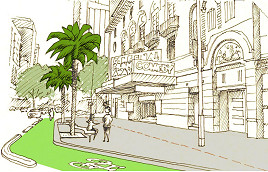Council has its say over state-wide infrastructure
By Jess Carrascalao Heard
The City of Melbourne has had its first say on the Victorian Government’s draft 30-year Infrastructure Strategy, after the Future Melbourne Committee (FMC) endorsed the council’s submission at a meeting earlier this month.
The submission, which looks at the state-wide strategy through a City of Melbourne policy lens, offers several amendments and recommendations on the likes of climate change mitigation, water management, transport development and future housing affordability.
It also highlights key opportunities for fast-tracking existing projects to help mitigate the economic impact of COVID-19, and advocates for sustained funding of the development of the CBD as a significant state- and nation-wide economic driver.
Deputy Lord Mayor Nicholas Reece described the central city as “the engine of the Victorian economy”.
“The development of the central city is absolutely crucial to the health of the entire state, and indeed, the nation, in terms of research, education, high productivity, jobs, innovation and Australia’s most important business cluster,” he said.
In the submission, one of the key opportunities identified for immediate action was investment in “foundational and catalytic infrastructure” for the urban renewal areas of Arden, Macaulay and Fishermans Bend.
The council said that new infrastructure in those areas needed to address issues including flood mitigation, integrated water management, open space acquisition and key transport connections.
Transport plans would include a tram extension to Fishermans Bend, which would decrease the need for car parking in future development of the area.
“Early delivery of this infrastructure will affect the development outcomes in these areas – a new school encourages the market to consider family housing,” the submission stated.
Cr Reece said the submission strongly supported investment and infrastructure to ensure development in urban renewal projects could continue.
“Fishermans Bend, Arden and Macaulay [are] all areas that we must see reach their full potential in the years ahead, particularly as Melbourne resumes its population growth trajectory,” he said.
The council has also included urban renewal as one of its proposed amendments to recommendation 36 in the strategy, which seeks to deliver very low-income housing with inclusionary zoning.
The council’s amendment stated that “higher affordable housing requirements be introduced in urban renewal areas”, recognising that the value of land could increase due to improved government infrastructure, which could, in turn, make housing unaffordable.
“A portion of the increase in land value may be captured by the government to provide public benefit. Affordable housing is an example of a public benefit,” the submission stated.
Housing is just one of several issues covered in the draft 30-Year Infrastructure Strategy.
The draft strategy includes 95 recommendations across four key areas of consideration for future infrastructure:
- Confront long-term challenges (including the changing climate and embracing technological opportunities);
- Manage urban change (including integrating land use and infrastructure planning, and steering changes in travel behaviour);
- Harness infrastructure for productivity and growth (including shaping the transport network for better access); and
- Develop regional Victoria.
The City of Melbourne submission has addressed 70 of the 95 recommendations in the draft strategy, stating that there were “strong synergies” between the draft infrastructure strategy and the council’s existing strategies.
Transport pricing forms a number of the recommendations in the draft strategy, including a trial of demand-responsive parking pricing, congestion pricing as well as an increase and extension of the Melbourne Congestion Levy on parking, in a bid to encourage public transport use and reduce traffic congestion.
But also in its submission, the council recommended that any increase in levy amounts should not happen until car numbers in the area reached pre-COVID levels, with the current temporary discount providing COVID relief.
The Free Tram Zone is also under threat in the draft strategy, but the council’s submission recommended that a cost-benefit analysis should be done before any changes to the Free Tram Zone were considered.
An emphasis on walking as a key mode of transport in the central city is also highlighted in the submission, with a recommendation to elevate future plans for walking as a separate mode of transport to cycling.
The transition to a greener future for the state is also reflected in other parts of the draft strategy.
Climate change mitigation measures include ensuring water security by considering a broader range of water supply sources and fast-tracking water cycle management, allowing better use of both stormwater and recycled water.
The council has pushed for these recommendations further by suggesting a more holistic approach, including the consideration of combined alternative water sources for non-potable uses, which would decrease the demand for drinking water.
Suggestions for investment in “green” and “blue infrastructure”, and the protection and incorporation of green infrastructure in transport corridors to support climate change adaption is also included in the City of Melbourne’s submission.
Speaking at the FMC meeting, Cr Rohan Leppert said that the opportunity council had been given to offer its input on the strategy was rare.
He said he hoped the council’s recommendations would translate into political will at the state level to implement some of the ideas in the 30-year strategy.
“Whether it’s on transport pricing, or housing, or renewable energy networks, there is a lot in there that we should be amplifying,” he said.
The City of Melbourne’s submission will form part of the feedback on the draft strategy during the current consultative phase.
The final strategy is due to be published in mid-2021 •

Council endorses office tower at Flinders Lane despite querying car park demolition




 Download the Latest Edition
Download the Latest Edition